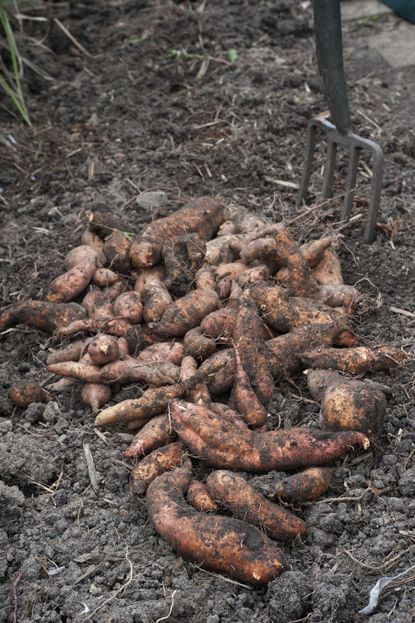Sweet Potato Storage – Tips On Storing Sweet Potatoes For Winter


Sweet potatoes are versatile tubers that have fewer calories than traditional potatoes and are a perfect stand-in for that starchy vegetable. You can have homegrown tubers for months past the growing season if you know how to store sweet potatoes after the harvest. Sweet potato storage requires careful curing to prevent mildew and to trigger the formation of sugar-producing enzymes. Curing is the key to harvesting and storing sweet potatoes for months of enjoyment.
Storing Sweet Potatoes for Winter
Sweet potatoes are delicious eaten right after harvest, but their true flavors deepen as they cure. During the curing process, the starches in the tuber turn into sugar, intensifying the buttery sweet flavor and texture of the potato. Once the curing process has been finished, the sweet potatoes are ready to be packed for long-term storage. Traditional methods recommend storing sweet potatoes in some sand, but you can also use a box or perforated plastic bag in the right temperatures and conditions. Curing is crucial to storing sweet potatoes for winter successfully. Harvest the potatoes in a dry period if possible. Try to minimize any damage to the tuber, as it invites mold, insects, and disease. Lay out the tubers carefully and let them dry for 10 days to 2 weeks in a warm location with high humidity. Ideal temperatures are 80 to 85 F. (26 to 29 C.) with a humidity level of 80 percent. To cure the potatoes indoors, store them near the furnace, packed in boxes covered with a cloth to enhance humidity. Temperatures indoors generally range from 65 to 75 F. (15 to 23 C.), so a longer period of 2 weeks curing is recommended.
How to Store Sweet Potatoes After Harvest
Provided proper steps are taken during harvesting and storing sweet potatoes, the tubers should last well into winter. After the curing period is up, brush off any dirt that may still remain on the potatoes. Pack them in paper boxes or wrap them in newspaper and store them in a cool pantry or closet. The best temperature to keep the roots fresh is 55 to 60 F. (12 to 15 C.) but don’t refrigerate them for more than a few days, as they are susceptible to cold injury. Check the sweet potatoes often and remove any that may start to mildew to prevent the fungus from spreading to the other tubers.
Traditional In-Site Banking
Our grandparents would place the tubers in a situation called banking. This required circular beds with foot-high (0.5 m.) earthen walls to be prepared. The base of the circle was covered with straw and the potatoes piled up in a cone structure. Then a tepee structure of boards was erected over the pile and more straw packed on top. Earth was gradually mounded over the 6 to 10 inches (15-25.5 cm.) of top straw with more boards placed over the apex of the tepee to prevent moisture from running into the pile. The key with this type of sweet potato storage was to provide ventilation, prevent water from entering and keep the tubers cool but not allow them to freeze.
Storing Sweet Potatoes in Sand
It is not recommended to bank the tubers in sand because it doesn’t allow for adequate ventilation. However, you can store them in sand packed in layers in barrels or crates. The sand cushions them and prevents injury and keeps the sweet potatoes cool enough while preventing a freeze. This method works best if the barrel is stored in a warmish basement or modestly warm garage. Root cellars may also work well if they are not in a zone where deep freezes are common.
Gardening tips, videos, info and more delivered right to your inbox!
Sign up for the Gardening Know How newsletter today and receive a free download of our most popular eBook "How to Grow Delicious Tomatoes."

Bonnie Grant is a professional landscaper with a Certification in Urban Gardening. She has been gardening and writing for 15 years. A former professional chef, she has a passion for edible landscaping.
-
 How To Get Rid Of Mosquitoes In The Garden: 9 Natural Ways To Make Them Buzz Off!
How To Get Rid Of Mosquitoes In The Garden: 9 Natural Ways To Make Them Buzz Off!How to get rid of mosquitoes is on the minds of people in the summer in almost every region of the world. Learn how to repel the pests without toxic chemicals.
By Mary Ellen Ellis
-
 Monkey Orchid Care: How To Grow This Fascinating Species
Monkey Orchid Care: How To Grow This Fascinating SpeciesThe monkey orchid bears a remarkable resemblance to its namesake and, with a little know-how, can be successfully grown as a houseplant.
By Bonnie L. Grant